Domain-Aware Adaptive Logarithmic Transformation
Abstract
1. Introduction
2. Related Work and Adaptive Logarithm Transformation Model
| Researcher | Expression | Advantage | Disadvantage |
|---|---|---|---|
| Stockham [27] | Strictly mapped to the interval | The luminance compression is excessive; The lost of high contrast content. | |
| Dargo [10] | Well-suited to the specific image content | Parameter b needs to be adjusted for different images; Local contrast reduction | |
| Gu [28] | Enhancing low-light areas of the image; Improving the overall brightness of the image | Overexposure may occur | |
| Vinker [21] | Adaptive searching for appropriate mapping curves | High computational complexity; Not strictly normalized to the interval |
3. Domain-Aware Objective Function
3.1. Luminance-Domain-Aware AdaLogT Method
| Algorithm 1: Trichotomy method for optimum value |
 |
3.2. Gradient-Domain-Aware AdaLogT Method
4. AdaLogT Method for DNN-Based TM Algorithms
- (1)
- Normalization. , but when . In other words, Equation (6) does not strictly map the input luminance to . If we modify Equation (6) to:Then .In this case , the selection of is transformed into the problem of selection of p.
- (2)
- Computational complexity. Equation (7) uses the mean of the luminance histograms of 900 LDR images in the DIV2k [29] dataset as reference. Ideally, the calculation of the histogram means should use the distance between distributions, such as earth mover’s distance (EMD) [39], which is computationally expensive. Specifically, Vinker uses the stochastic search method [40] to find suitable values within 1 to and uses a floating point type with a high degree of computational accuracy, which needs to be continually performed. Depending on the variation of the mapping curve with different parameters in Figure 2, there is less gain in increased accuracy as it takes a large parameter change to make a significant difference to the curve. Figure 7 gives a comparison of ACC and AdaLogT execution times and shows that ACC has a far greater computational complexity than AdaLogT.
5. Experimental Results and Analysis
5.1. Luminance-Domain Algorithm
5.2. Gradient-Domain Algorithm
5.3. DNN-Based TM Algorithm
6. Conclusions
Author Contributions
Funding
Data Availability Statement
Acknowledgments
Conflicts of Interest
References
- DiCarlo, J.M.; Wandell, B.A. Rendering high dynamic range images. In Sensors and Camera Systems for Scientific, Industrial, and Digital Photography Applications; SPIE: Bellingham, WA, USA, 2000; Volume 3965, pp. 392–401. [Google Scholar]
- Reinhard, E.; Heidrich, W.; Debevec, P.; Pattanaik, S.; Ward, G.; Myszkowski, K. High Dynamic Range Imaging: Acquisition, Display, and Image-Based Lighting; Morgan Kaufmann: Burlington, MA, USA, 2010. [Google Scholar]
- Eilertsen, G.; Mantiuk, R.K.; Unger, J. A comparative review of tone-mapping algorithms for high dynamic range video. In Computer Graphics Forum; Wiley Online Library: New York, NY, USA, 2017; Volume 36, pp. 565–592. [Google Scholar]
- Gibbon, J. Scalar expectancy theory and Weber’s law in animal timing. Psychol. Rev. 1977, 84, 279. [Google Scholar] [CrossRef]
- Durand, F.; Dorsey, J. Fast bilateral filtering for the display of high-dynamic-range images. In Proceedings of the 29th Annual Conference on Computer Graphics and Interactive Techniques, San Antonio, TX, USA, 23–26 July 2002; pp. 257–266. [Google Scholar]
- Farbman, Z.; Fattal, R.; Lischinski, D.; Szeliski, R. Edge-preserving decompositions for multi-scale tone and detail manipulation. ACM Trans. Graph. (TOG) 2008, 27, 1–10. [Google Scholar] [CrossRef]
- Paris, S.; Hasinoff, S.W.; Kautz, J. Local laplacian filters: Edge-aware image processing with a laplacian pyramid. ACM Trans. Graph. 2011, 30, 68. [Google Scholar] [CrossRef]
- Liang, Z.; Xu, J.; Zhang, D.; Cao, Z.; Zhang, L. A hybrid l1-l0 layer decomposition model for tone mapping. In Proceedings of the IEEE Conference on Computer Vision and Pattern Recognition, Salt Lake City, UT, USA, 18–23 June 2018; pp. 4758–4766. [Google Scholar]
- Yang, K.F.; Li, H.; Kuang, H.; Li, C.Y.; Li, Y.J. An adaptive method for image dynamic range adjustment. IEEE Trans. Circuits Syst. Video Technol. 2018, 29, 640–652. [Google Scholar] [CrossRef]
- Drago, F.; Myszkowski, K.; Annen, T.; Chiba, N. Adaptive logarithmic mapping for displaying high contrast scenes. In Computer Graphics Forum; Wiley Online Library: New York, NY, USA, 2003; Volume 22, pp. 419–426. [Google Scholar]
- Zhao, L.; Li, G.; Wang, J. Tone Mapping Method Based on the Least Squares Method. Electronics 2022, 12, 31. [Google Scholar] [CrossRef]
- Zhao, L.; Sun, R.; Wang, J. Three-Stage Tone Mapping Algorithm. Electronics 2022, 11, 4072. [Google Scholar] [CrossRef]
- Land, E.H. The retinex theory of color vision. Sci. Am. 1977, 237, 108–129. [Google Scholar] [CrossRef]
- Mantiuk, R.; Daly, S.; Kerofsky, L. Display adaptive tone mapping. In ACM SIGGRAPH 2008 Papers on—SIGGRAPH ’08. ACM Press: New York, NY, USA, 2008; pp. 1–10. [Google Scholar]
- Khan, I.R.; Rahardja, S.; Khan, M.M.; Movania, M.M.; Abed, F. A tone-mapping technique based on histogram using a sensitivity model of the human visual system. IEEE Trans. Ind. Electron. 2017, 65, 3469–3479. [Google Scholar] [CrossRef]
- Fattal, R.; Lischinski, D.; Werman, M. High dynamic range compression. In Proceedings of the 29th Annual Conference on Computer Graphics and Interactive Techniques, San Antonio, TX, USA, 23–26 July 2002; pp. 249–256. [Google Scholar]
- Bhat, P.; Zitnick, C.L.; Cohen, M.; Curless, B. Gradientshop: A gradient-domain optimization framework for image and video filtering. ACM Trans. Graph. (TOG) 2010, 29, 1–14. [Google Scholar] [CrossRef]
- Shibata, T.; Tanaka, M.; Okutomi, M. Gradient-domain image reconstruction framework with intensity-range and base-structure constraints. In Proceedings of the IEEE Conference on Computer Vision and Pattern Recognition, Las Vegas, NV, USA, 27–30 June 2016; pp. 2745–2753. [Google Scholar]
- Rana, A.; Singh, P.; Valenzise, G.; Dufaux, F.; Komodakis, N.; Smolic, A. Deep tone mapping operator for high dynamic range images. IEEE Trans. Image Process. 2019, 29, 1285–1298. [Google Scholar] [CrossRef]
- Panetta, K.; Kezebou, L.; Oludare, V.; Agaian, S.; Xia, Z. Tmo-net: A parameter-free tone mapping operator using generative adversarial network, and performance benchmarking on large scale hdr dataset. IEEE Access 2021, 9, 39500–39517. [Google Scholar] [CrossRef]
- Vinker, Y.; Huberman-Spiegelglas, I.; Fattal, R. Unpaired learning for high dynamic range image tone mapping. In Proceedings of the IEEE/CVF International Conference on Computer Vision, Nashville, TN, USA, 20–25 June 2021; pp. 14657–14666. [Google Scholar]
- Cao, X.; Lai, K.K.; Smith, M.R.; Yanushkevich, S. Adversarial and adaptive tone mapping operator: Multi-scheme generation and multi-metric evaluation. J. Electron. Imaging 2021, 30, 043020. [Google Scholar] [CrossRef]
- Xu, J.; Hou, Y.; Ren, D.; Liu, L.; Zhu, F.; Yu, M.; Wang, H.; Shao, L. Star: A structure and texture aware retinex model. IEEE Trans. Image Process. 2020, 29, 5022–5037. [Google Scholar] [CrossRef]
- Azimi, M.; Boitard, R.; Nasiopoulos, P.; Pourazad, M.T. Visual color difference evaluation of standard color pixel representations for high dynamic range video compression. In Proceedings of the 2017 25th European Signal Processing Conference (EUSIPCO), Kos, Greece, 28 August–2 September 2017; pp. 1480–1484. [Google Scholar]
- Duan, J.; Qiu, G.; Chen, M. Comprehensive fast tone mapping for high dynamic range image visualization. In Pacific Graphics; Citeseer: Macau, China, 2005. [Google Scholar]
- Zhang, Z.; Han, C.; He, S.; Liu, X.; Zhu, H.; Hu, X.; Wong, T.T. Deep binocular tone mapping. Vis. Comput. 2019, 35, 997–1011. [Google Scholar] [CrossRef]
- Stockham, T.G. Image processing in the context of a visual model. Proc. IEEE 1972, 60, 828–842. [Google Scholar] [CrossRef]
- Gu, B.; Li, W.; Zhu, M.; Wang, M. Local edge-preserving multiscale decomposition for high dynamic range image tone mapping. IEEE Trans. Image Process. 2012, 22, 70–79. [Google Scholar] [PubMed]
- Agustsson, E.; Timofte, R. Ntire 2017 challenge on single image super-resolution: Dataset and study. In Proceedings of the IEEE Conference on Computer Vision and Pattern Recognition Workshops, Honolulu, HI, USA, 21–26 July 2017; pp. 126–135. [Google Scholar]
- Boschetti, A.; Adami, N.; Leonardi, R.; Okuda, M. High dynamic range image tone mapping based on local histogram equalization. In Proceedings of the 2010 IEEE International Conference on Multimedia and Expo, Beijing, China, 26–28 October 2010; pp. 1130–1135. [Google Scholar]
- Khan, I.R.; Aziz, W.; Shim, S.O. Tone-mapping using perceptual-quantizer and image histogram. IEEE Access 2020, 8, 31350–31358. [Google Scholar] [CrossRef]
- Reinhard, E.; Stark, M.; Shirley, P.; Ferwerda, J. Photographic tone reproduction for digital images. In Proceedings of the 29th Annual Conference on Computer Graphics and Interactive Techniques, San Antonio, TX, USA, 23–26 July 2002; pp. 267–276. [Google Scholar]
- Li, Z.; Zheng, J. Visual-salience-based tone mapping for high dynamic range images. IEEE Trans. Ind. Electron. 2014, 61, 7076–7082. [Google Scholar] [CrossRef]
- Barai, N.R.; Kyan, M.; Androutsos, D. Human visual system inspired saliency guided edge preserving tone-mapping for high dynamic range imaging. In Proceedings of the 2017 IEEE International Conference on Image Processing (ICIP), Beijing, China, 17–20 September 2017; pp. 1017–1021. [Google Scholar]
- Mertens, T.; Kautz, J.; Van Reeth, F. Exposure fusion. In Proceedings of the 15th Pacific Conference on Computer Graphics and Applications (PG’07), Maui, HI, USA, 29 October–2 November 2007; pp. 382–390. [Google Scholar]
- Mertens, T.; Kautz, J.; Van Reeth, F. Exposure fusion: A simple and practical alternative to high dynamic range photography. In Computer Graphics Forum; Wiley Online Library: New York, NY, USA, 2009; Volume 28, pp. 161–171. [Google Scholar]
- Guo, C.; Li, C.; Guo, J.; Loy, C.C.; Hou, J.; Kwong, S.; Cong, R. Zero-reference deep curve estimation for low-light image enhancement. In Proceedings of the IEEE/CVF Conference on Computer Vision and Pattern Recognition, Seattle, WA, USA, 13–19 June 2020; pp. 1780–1789. [Google Scholar]
- Miao, D.; Zhu, Z.; Bai, Y.; Jiang, G.; Duan, Z. Novel tone mapping method via macro-micro modeling of human visual system. IEEE Access 2019, 7, 118359–118369. [Google Scholar] [CrossRef]
- Panaretos, V.M.; Zemel, Y. Statistical aspects of Wasserstein distances. Annu. Rev. Stat. Its Appl. 2019, 6, 405–431. [Google Scholar] [CrossRef]
- Storn, R.; Price, K. Differential Evolution—A simple and efficient heuristic for global optimization over continuous spaces. J. Glob. Optim. 1997, 11, 341. [Google Scholar] [CrossRef]
- Yeganeh, H.; Wang, Z. Objective quality assessment of tone-mapped images. IEEE Trans. Image Process. 2012, 22, 657–667. [Google Scholar] [CrossRef] [PubMed]

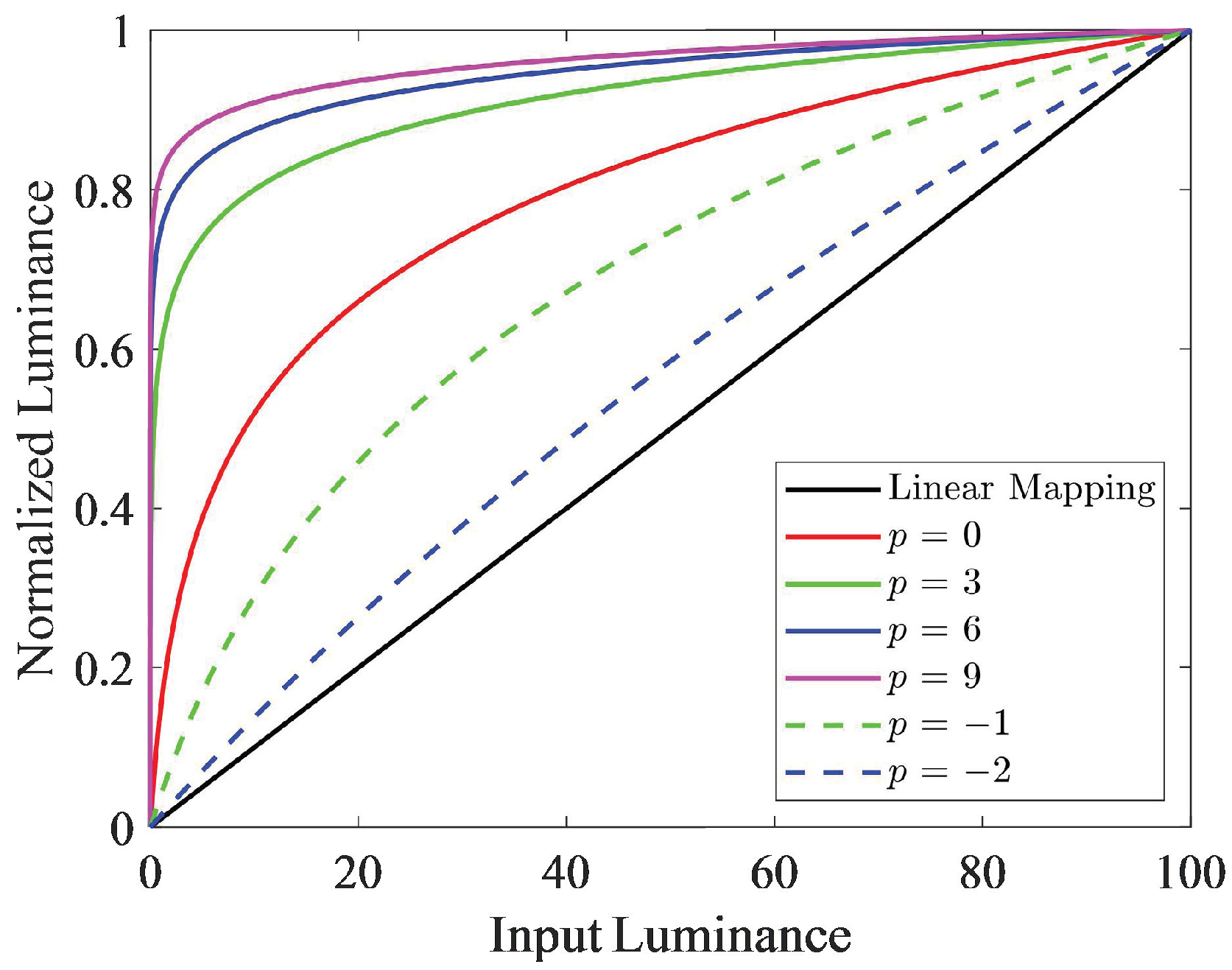

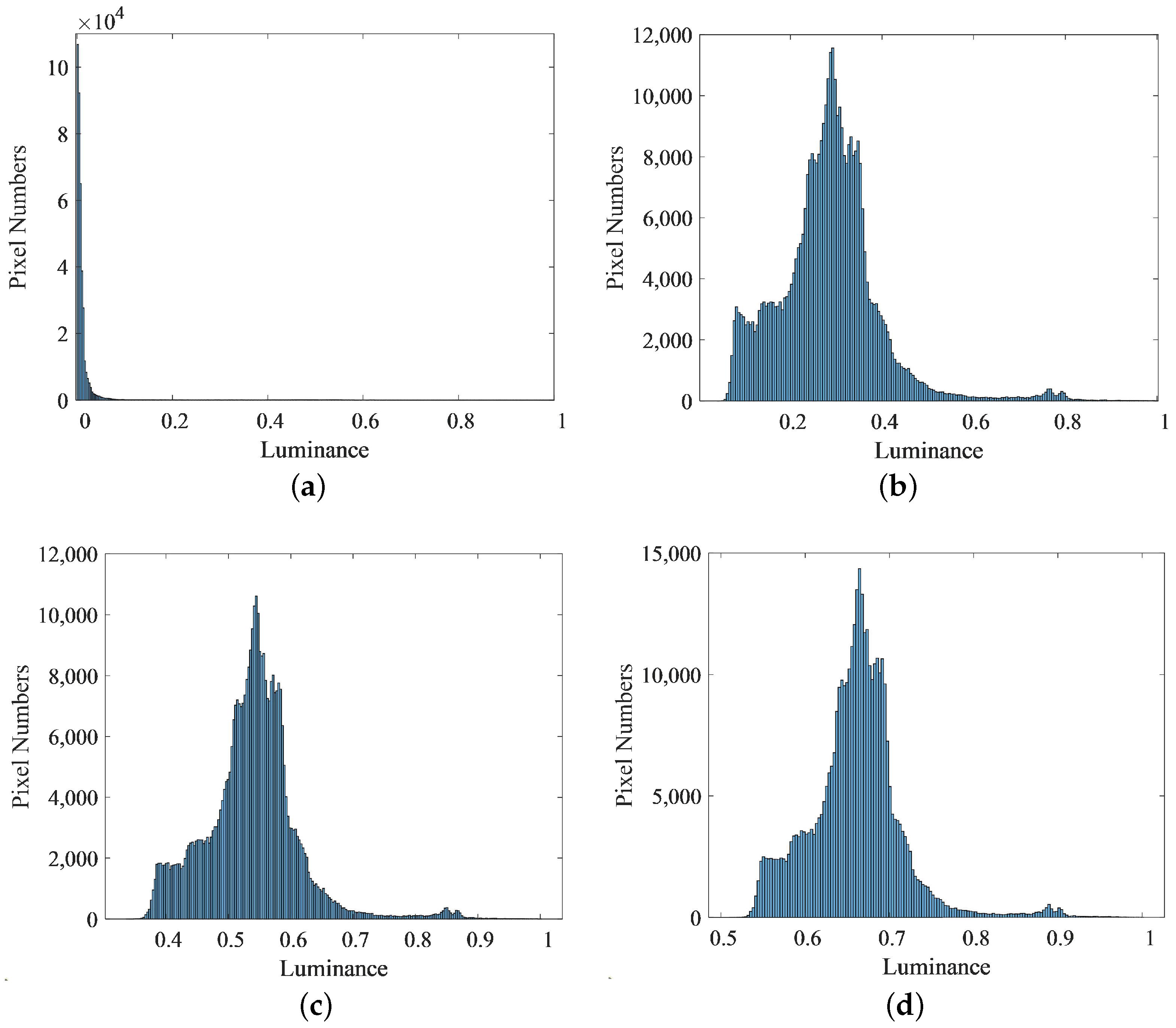



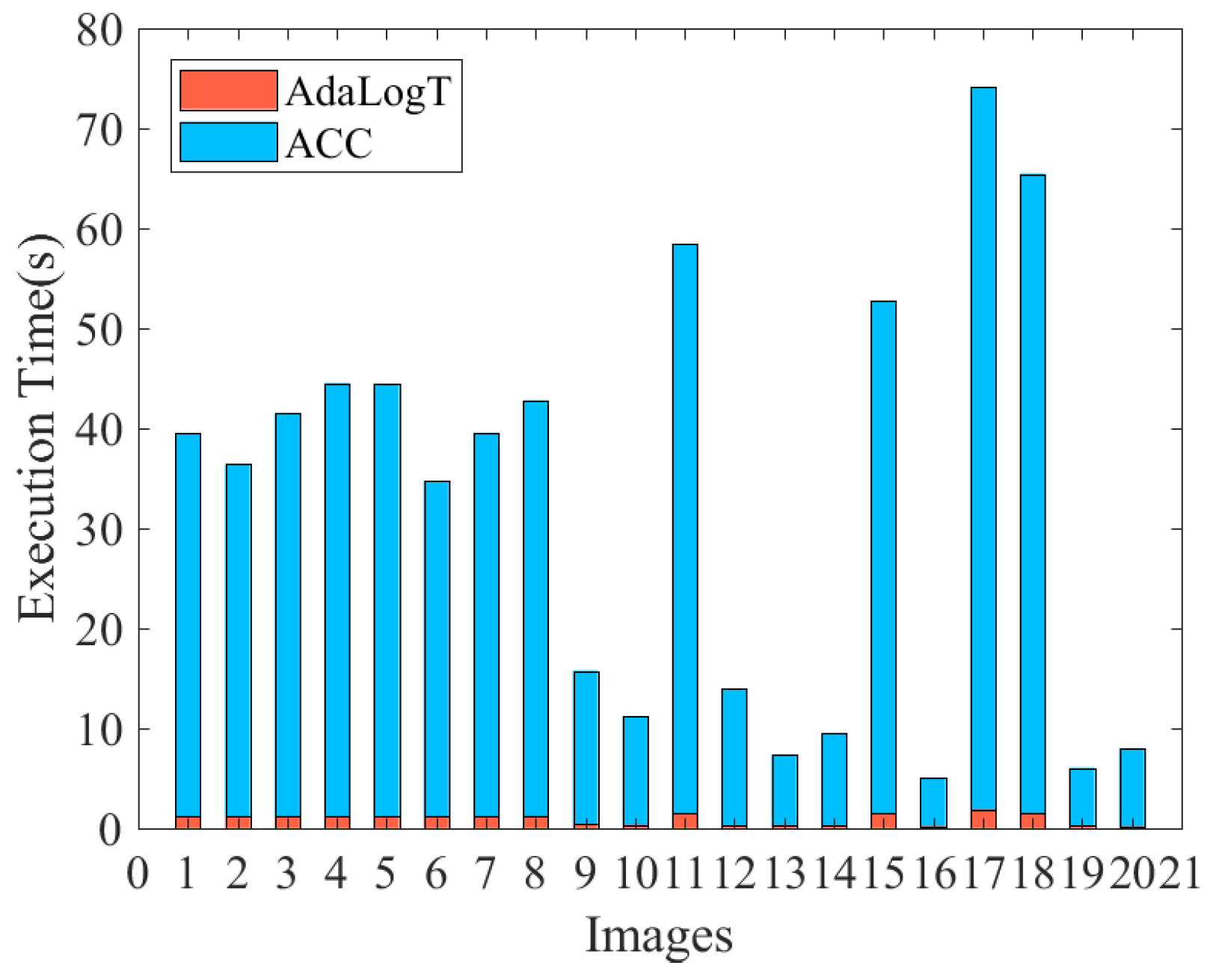
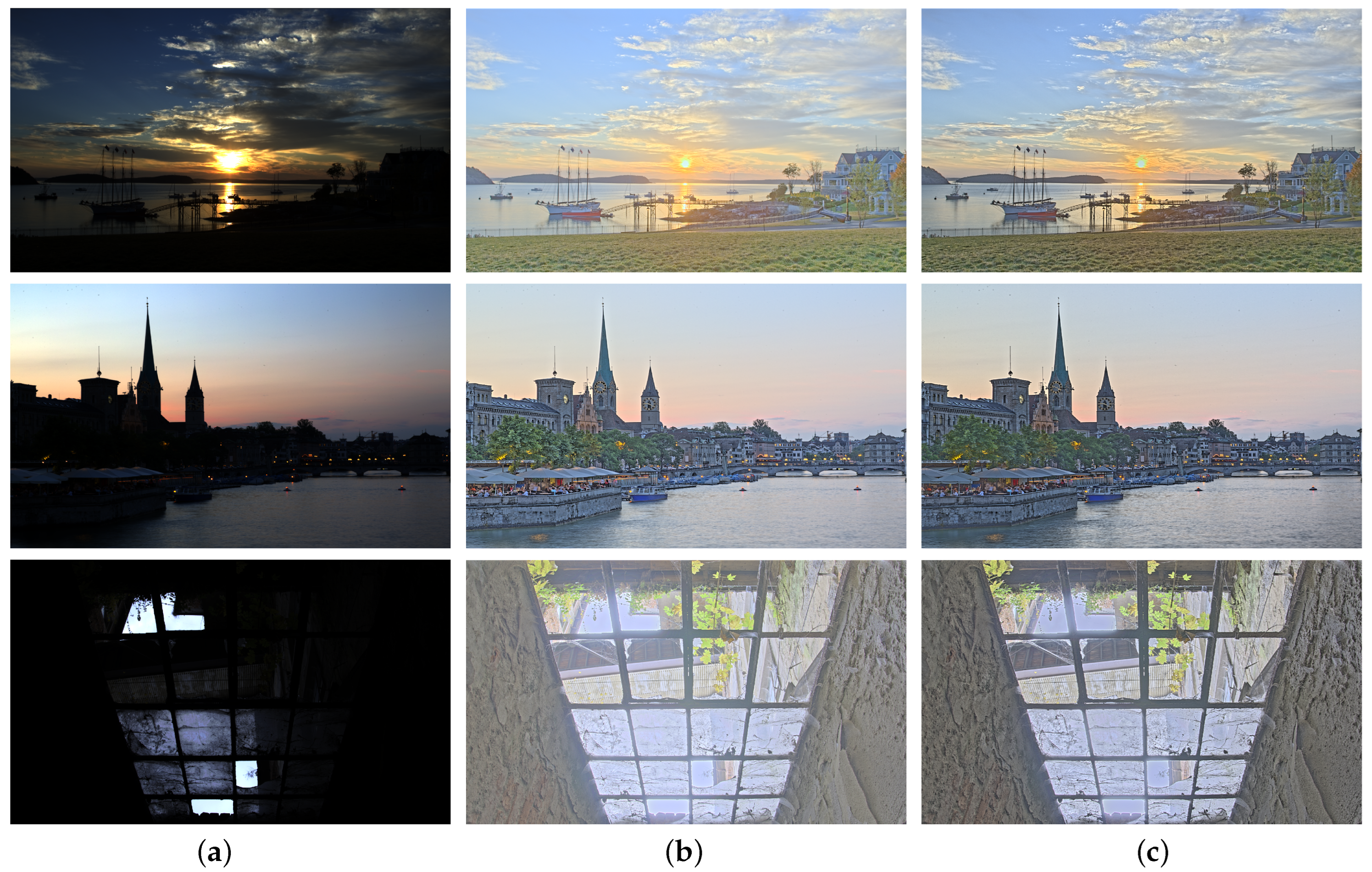
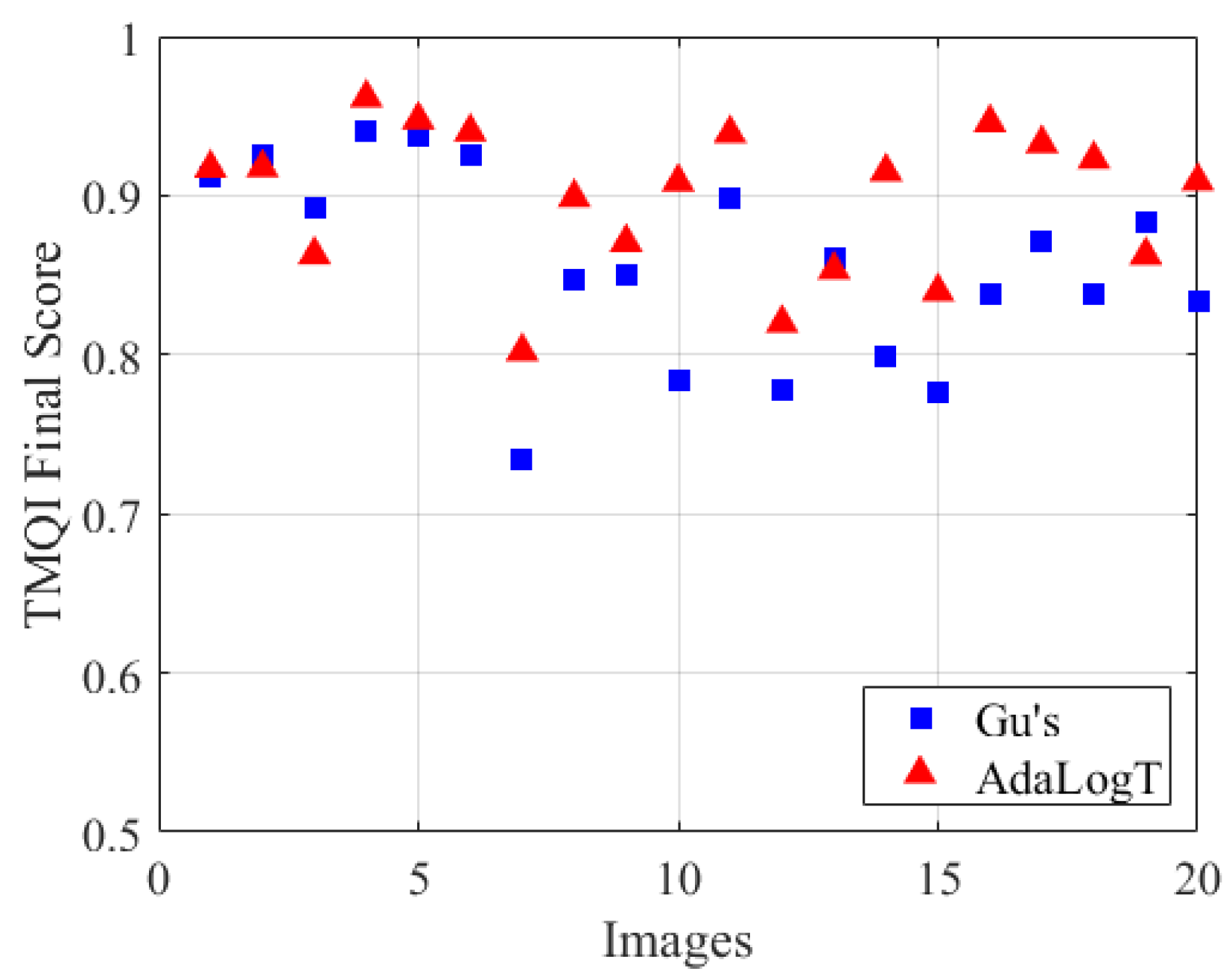
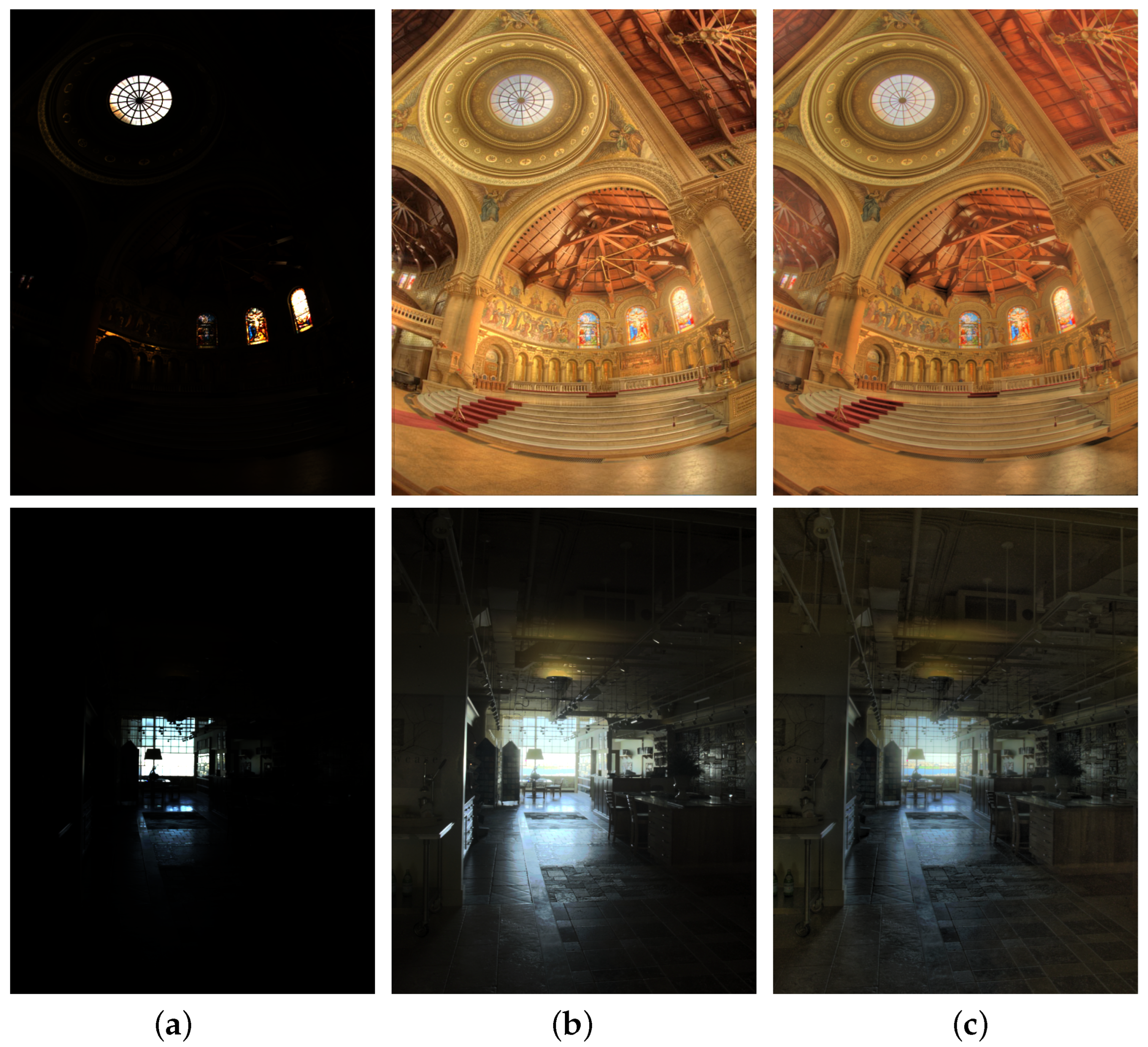
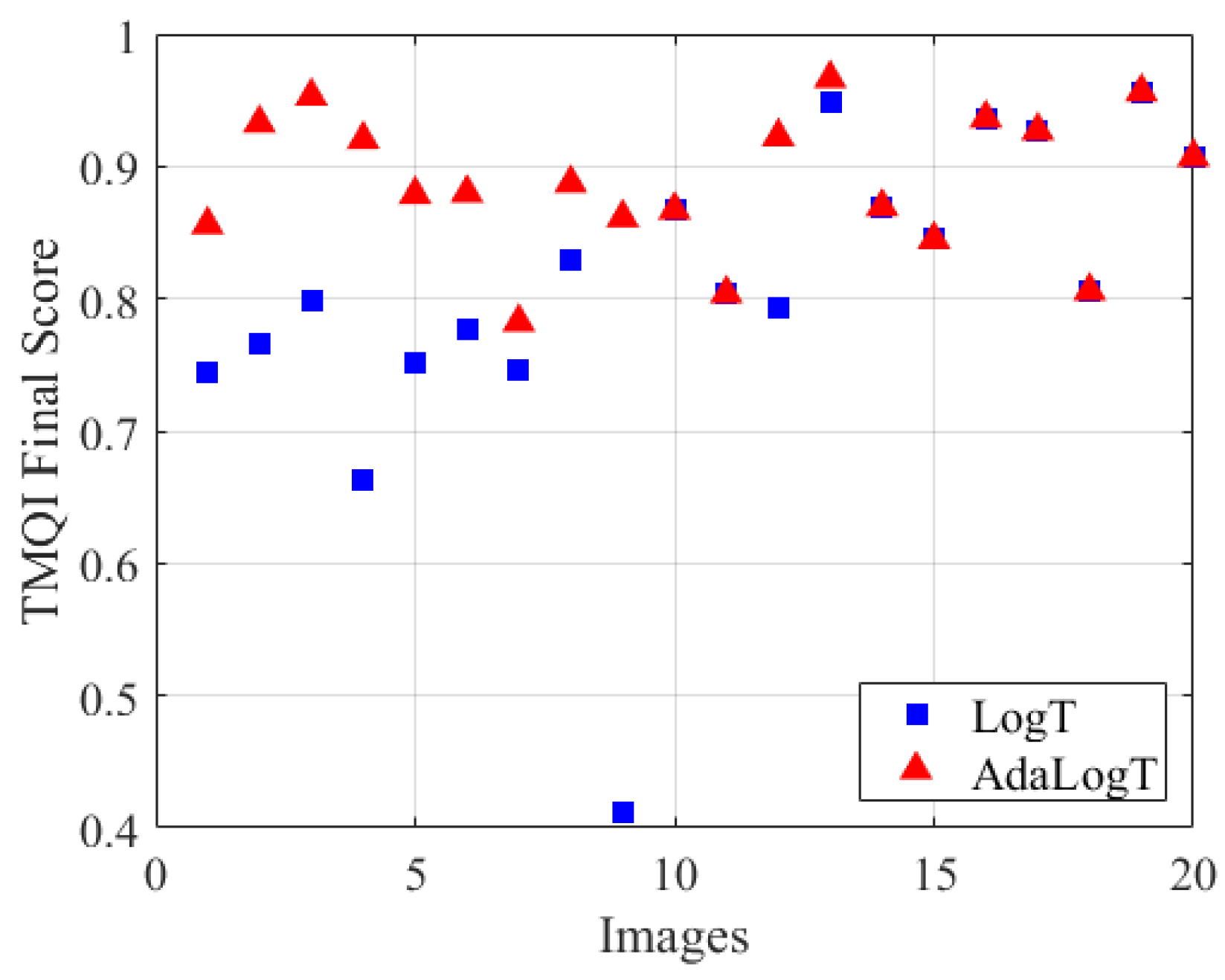
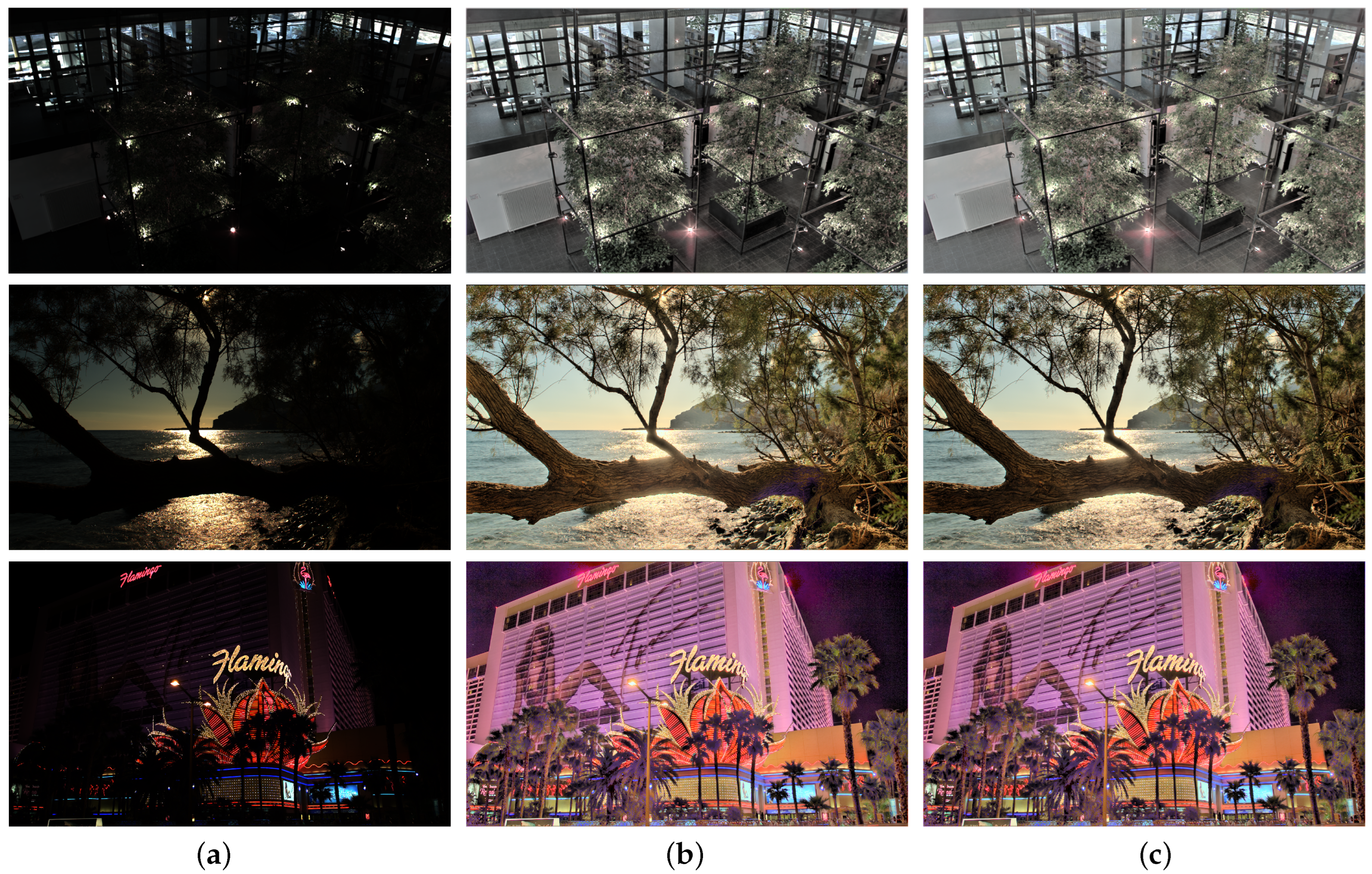

| Preprocessing | Structure | Naturalness | Final |
|---|---|---|---|
| Gu’s | 0.8273 | 0.4098 | 0.8562 |
| AdaLogT | 0.8305 | 0.6346 | 0.8983 |
| Preprocessing | Structure | Naturalness | Final |
|---|---|---|---|
| LogT | 0.8104 | 0.2577 | 0.8072 |
| AdaLogT | 0.8647 | 0.5272 | 0.8879 |
| Preprocessing | Structure | Naturalness | Final |
|---|---|---|---|
| ACC | 0.8587 | 0.5398 | 0.8872 |
| AdaLogT | 0.8798 | 0.6383 | 0.9129 |
Disclaimer/Publisher’s Note: The statements, opinions and data contained in all publications are solely those of the individual author(s) and contributor(s) and not of MDPI and/or the editor(s). MDPI and/or the editor(s) disclaim responsibility for any injury to people or property resulting from any ideas, methods, instructions or products referred to in the content. |
© 2023 by the authors. Licensee MDPI, Basel, Switzerland. This article is an open access article distributed under the terms and conditions of the Creative Commons Attribution (CC BY) license (https://creativecommons.org/licenses/by/4.0/).
Share and Cite
Fang, X.; Feng, X. Domain-Aware Adaptive Logarithmic Transformation. Electronics 2023, 12, 1318. https://doi.org/10.3390/electronics12061318
Fang X, Feng X. Domain-Aware Adaptive Logarithmic Transformation. Electronics. 2023; 12(6):1318. https://doi.org/10.3390/electronics12061318
Chicago/Turabian StyleFang, Xuelai, and Xiangchu Feng. 2023. "Domain-Aware Adaptive Logarithmic Transformation" Electronics 12, no. 6: 1318. https://doi.org/10.3390/electronics12061318
APA StyleFang, X., & Feng, X. (2023). Domain-Aware Adaptive Logarithmic Transformation. Electronics, 12(6), 1318. https://doi.org/10.3390/electronics12061318








